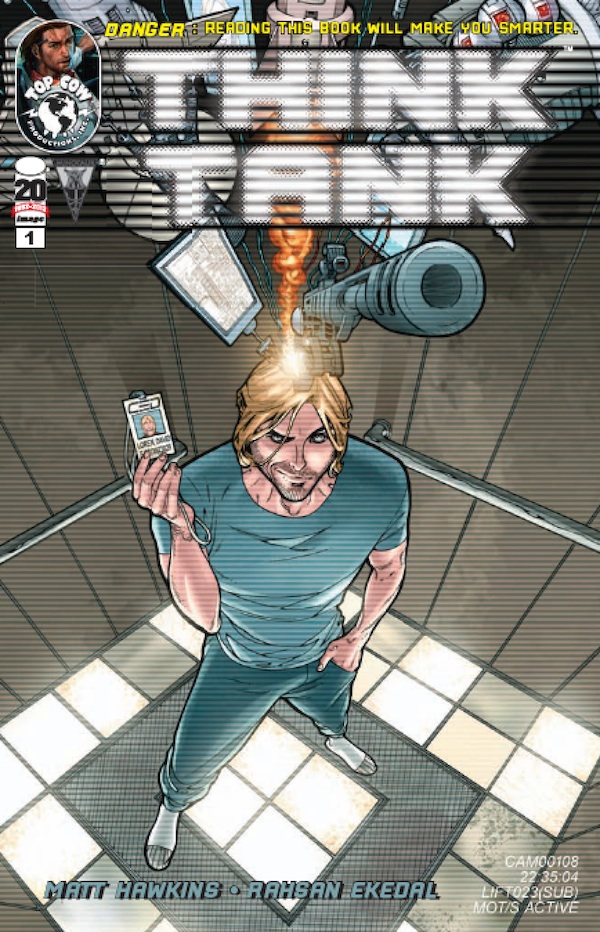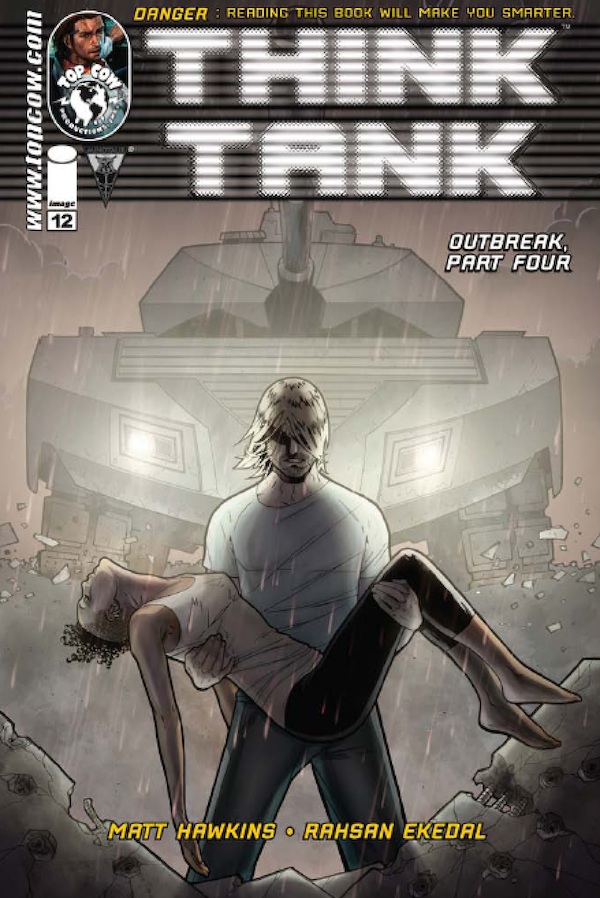
Somerville comic artist Maris Wicks was tapped to illustrate another fine Jim Ottaviani science book and the result is Primates from First Second. Jim and Maris were kind enough to talk with us about observers that inspire us. Primates is the story of “Leakey’s Angels”—Jane Goodall, Dian Fossey, and Biruté Galdika—and is a beautifully crafted story, lushly illustrated for all audiences. Get your feet wet in the jungle with us as we swing from the trees!
DIGBOSTON: Hi Jim and Maris, thanks for taking the time to talk about Primates. The response to the book seems extremely positive so far. Why a comic about Jane Goodall, Dian Fossey, and Biruté Galdikas? More specifically, why choose comics to tell your story?
JIM OTTAVIANI: I’ve been writing comics about scientists for more than 15 years now, so in one sense I’ve gotten into the habit of telling stories using comics. But the reason I started to do it in the first place is because I suspected it would work. And it does!
It’s no coincidence that scientists communicate with each other using words and pictures all the time.
In fact, I was just in the other Cambridge doing research for an upcoming book, and the scientists I talked to were adamant: they couldn’t do physics without drawing pictures. The ones I talked to had a strong preference for chalk over dry erase markers too, for what that’s worth!
As for Jane Goodall, Dian Fossey, and Biruté Galdikas, I wanted to learn more about them, and it turns out the best way for me to learn is to give myself a writing assignment. I also like stories about tough, intelligent, and courageous people changing the way we think about ourselves and our place in the world. And these three scientists were and are all of those things, and did just that.
Maris, How did you get approached to illustrate this story?
MARIS WICKS: In the spring of 2008, I was contacted by First Second Books; they were looking for artists to submit samples for the script of Primates. So I essentially “tried out” for the book. I should back up by saying that I had been going to indie comics conventions since 2002, and selling my self-published comics. In 2006, I worked with Adhouse Books on their anthology Project: Romantic (I did the cover, spot illustrations, and a 12-page story). Prior to that, I had done a handful of editorial and educational illustrations for various non-comics publications and institutions. So I was just starting out in comics.
Do you love drawing animals? I’m sure your drawing research was intense. Did Jim feed you the reference you needed for the apes and orangutans?
MARIS: Um, YES I LOVE DRAWING ANIMALS!!
When I started my work on Primates, Jim gave me a 3-inch stack of photocopied visual references (as well as a list of helpful books).
I also used a good amount of internet references, both pictures and videos. Sadly, I did not go on any exotic field trips (although I did visit the Harvard Museum of Natural History quite a few times). My other (non-comics) job is working at the New England Aquarium as a program educator, so I draw lots of non-primate animals in my spare time.

PRIMATES - art by Maris Wicks
This is a somewhat fictional account of these three ladies, care to tell us about how you are able to bridge the gap between research and comic book script?
JIM: The pictures build that bridge, I think. Because we had to imagine scenes from the point of view of our scientists or the primates they studied or even as seen by some other animal up in the trees are down among the fallen leaves on the forest floor, it freed us to think about how things felt, not just how things actually were. So even though there are fictional bits, I think — I hope — they were emotionally true, if you know what I mean.
And emotional truths are the tendons that hold together the factual truths that make up the backbone of any story.
Leakey’s Angels featured in the book are real life inspirational ladies in the field of archeology and ethology, prompting many girls (and boys) to study science. Do you have similar heroes that got you to start drawing?
MARIS: My mum always encouraged my artistic tendencies, and I had fabulous art professors in high school and college. As for early inspiration, I loved the illustrations of Maurice Sendack, Eric Carle, Edward Gorey, Arnold Lobel…I was also very fond of the book Koko’s Kitten (woo! gorillas!). In my early teens, I discovered the work of Evan Dorkin (Milk & Cheese, Dork), and that was pretty much my gateway drug into the realm of comics. Later comics influences include David Mazzucchelli (he was also my professor in college!), Hergé, and Darwyn Cooke. Aside from my mum, the author of Koko’s Kitten, I realize that all these folks I’ve listed so far are male…my contemporary influences reflect a much more diverse line-up. Science-writer Mary Roach and French comics artist Marion Montaigne (would some one PLEASE translate her comics into English already?) are some of my current inspirations.

PRIMATES - art by Maris Wicks
You’ve distilled the biography and research of at least three individuals down to an accurate tale, deftly weaving the lives of these three incredible ladies into this book. Did you also get to ‘know’ some of the primates featured in their research? Do you have a favorite?
JIM: An artist friend of mine once told me that all good cartoonists are method actors: They make the faces and adopt the body language of the characters they’re drawing. I took that to heart, and figured I should try to do that with my writing as well. Not that I can hang from a tree while typing or anything crazy like that, but I do think you can get to know your characters by imagining their actions and thoughts and coming up with ways to describe them. So yes, I think I got to know all of them.
As for favorites, I certainly don’t have a favorite among the scientists; they’re all heroes to me.
But with regards to the other primates in the book, I’m most partial to orangutans. Writers often need to, and like to, spend a lot of time alone, after all!
Has researching primates for this comic taught you anything about human behavior? In general what do you like most about working with or observing animals?
MARIS: I would have to say that both Primates AND my experience at the Aquarium have taught me a great deal about both science and education. I’m not sure if I can attest to human behavior specifically, but I’ve certainly learned a great deal about the importance of observation, creativity and critical thinking.
In both of my jobs, I hope to inspire a love of science to an audience of all ages and backgrounds.

PRIMATES - art by Maris Wicks
Science and comic book art are largely male dominated fields even today, which still seems strange to me. Just as you open the book to Jane Goodall reading Tarzan and dreaming of spending time with the apes, I picture a young lady reading this book and being equally inspired! What can be done—from small scales to large—in the worlds of science and art to change the gender paradigm?
JIM: Here’s a quote from the author Junot Diaz that I read the other day: “[I]f you want to make a human being into a monster, deny them, at the cultural level, any reflection of themselves.” The positive version of that might be that if you want to encourage excellence, show people what it looks like, and make sure they see something of themselves in your depiction of it.
MARIS: I agree! And Jim summed it up so eloquently. Just like how I mentioned above, so many of my early inspirations were male. But even now, there are more women scientists and artists and writers and (well, you get the picture), creating work not for women, for all people, inspiring future generations.
I think that having more stories about people of all genders, races, backgrounds, etc. is imperative to inspiring young readers.
I would also classify this book as all ages, meaning not just for the 12+ crowd to enjoy, but for all to enjoy, from our daughters to our grandparents. Do you think all ages books also have a timeless, enduring quality to them?
JIM: Thanks to joining a reading group a few years ago, and to the influence of a number of friends who write for young adults (Hi, Sara! Hi, Lara!) I now read a lot of books classified as young adult. They hold up even for this not-very-young-at-all adult. So, in short, yes!
MARIS: Totally! I think the term “all-ages” is sometimes misconstrued as being “just for kids”…the correct definition is exactly as you have stated it above: “[all ages books] have a timeless, enduring quality to them.” I sure hope the Primates fits this description!

PRIMATES (First Second Books) - MARIS WICKS (art) & JIM OTTAVIANI (author) - COVER
What other projects are you all working on? Can we see another collaboration between you two? Where can we find you online?
JIM: Leland Purvis and I have a book coming soon about Alan Turing, the mathematician, code breaker and computer scientist. It’s called “The Imitation Game” and it should be out in 2014…maybe sooner. Further out, the pile of books and notes on and around my desk is still rising as I do research for another book, which I can’t talk about just yet. I’m really excited about it and hope we can announce it soon.
I’ve also written a novella which may show up next year in some form, if I can get it right.
Fiction…turns out it’s hard!
And would I work with Maris again? That must be some kind of trick question, because the only possible answer is yes!
MARIS: I am currently at work on another graphic novel for First Second Books about the human body (I’m writing and drawing it!); it should be out in 2015 (so you’ll have to wait a little bit…sorry!). Smaller projects include regular 1-page marine biology comics for Spongebob Comics, a back-up Fionna and Cake story for Adventure Time Comics (written and drawn by me and Joe Quinones) and a Batman: Black and White story (written by me, drawn by Joe Quinones).
And, yes! Of course I would work with Jim again!
[READ MORE at DIGBOSTON.COM]
















